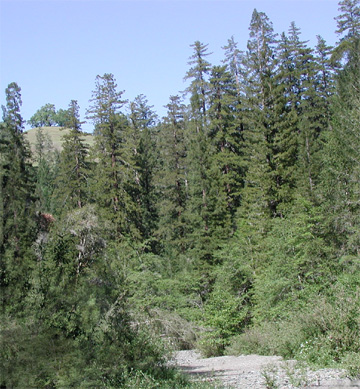| Introduction There are many ways of describing the
interrelationships of plants, animals, and their
environment. One method is to describe a Biological
Zone, or Biozone. Think of your own experience
when you have been out hiking: you think of a
forest as one type of wild place, a streamside
as another, and a grassland as another. Scientists
have taken this same approach. Each biozone is
given a name. Since the plants stay put and the
animals move around (it would be bad to have a
"deer zone" but not find any deer there,
right?), the zones are named after the
dominant plant of that zone. The Redwood
Biozone is one example: the redwood tree is the
dominant plant of this zone, and when you find
a redwood, you usually find other characteristic
plants, animals, rainfall, sunlight, and soil
conditions, as well as other factors such as elevation,
moisture, and similar influences.
No classification scheme is perfect for all applications,
and no biozone description is a perfect characterization
for every occurance of the dominant plant. However,
these descriptions are powerful ways to help us
see what exists in each biozone and to learn about the complex
interactions between the elements of the zone.
Look at the photograph at the right and see if
you can find the different zones described in
the caption.
The table below lists the biozones of California
according to Munz, the author of one of the definitive
plant books on California (second only to the
Jepson Manual). (Note: the table was adapted from
a summary by the Las
Pilitas
Nursery). |
 |
| This
photograph was taken looking upstream and across
the river from the baseball diamond. It shows
most of the biozones of Caz, from the grass field
at the top, to the redwood forest and finally,
at the botton, the riparian biozone. The oak woodland
is hidden behind the redwoods. |

